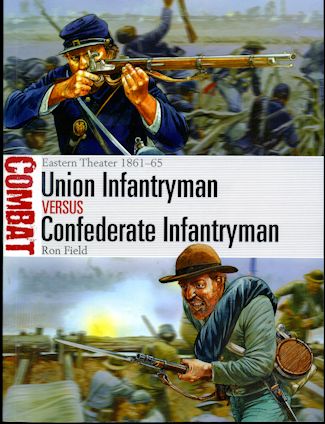Osprey's Union Infantryman vs Confederate Infantryman
|
Author: |
Ron Field |
|
Publisher |
Osprey |
|
Price |
$18.95 MSRP |
|
Reviewer: |
Scott Van Aken
|
|
Notes: |
80 pages, 7¼ x 9¼
inches, softbound
ISBN: 978-1-78096-927-5 |
 What many
consider the first 'modern' war, the US Civil War was pretty well one of those
deals that was predetermined. The highly industrialized north of the nation was
pitted against the mainly agrarian south. The north also held a greater
population to provide for a larger military. However, things were not as clear
cut at the time and there were factors in favor of the southern military. One
was that, thanks to a mostly rural population, experience with firearms was much
higher than in the mostly urban north. This resulted in a disparity in the
quality of the troops. The leadership of the south was also considered by many
to be generally better. In part because some of the best from the US Army
decided to go with their state and fought with the Confederacy.
What many
consider the first 'modern' war, the US Civil War was pretty well one of those
deals that was predetermined. The highly industrialized north of the nation was
pitted against the mainly agrarian south. The north also held a greater
population to provide for a larger military. However, things were not as clear
cut at the time and there were factors in favor of the southern military. One
was that, thanks to a mostly rural population, experience with firearms was much
higher than in the mostly urban north. This resulted in a disparity in the
quality of the troops. The leadership of the south was also considered by many
to be generally better. In part because some of the best from the US Army
decided to go with their state and fought with the Confederacy.
Many today do not realize how strong the feelings were for men in regard to
their states. It was sort of a 'mini-nationalism' where the good of the nation
as a whole wasn't as strong as allegiance to one's home and family. It helps to
explain why, with the capitals of the two parts so close together, neither was
captured early, despite many attempts.
This book concentrates on the eastern front during the war and looks at the
standard fighting soldier of both sides. This was a time when once a soldier's
agreed terms of service were over, he was free to simply grab his gear and
leave. Enlistments were short to begin with and this high turnover was often a
cause of frustration for career soldiers.
Three campaigns are covered in this book. First Manassas/Bull Run in 1861,
Gettysburg in 1863 and Chaffin's Farm/New Market Heights in 1864. The reason for
two names for some battles is how they were named by the two sides. What these
battles show is a progression from where the Confederates had the edge to the
turning point in the war and to the supremacy of the Union. It also showed how
battle changed with Bull Run being a more fluid fight, Gettysburg showing the
beginnings of fixed positions and Chaffin's Farm being one that was almost WWI
in nature due to the nature of the defenses. It also showed the changes in
tactics as the improvement in weaponry that was enjoyed by the north during that
time.
As with other books in this series, we look at
each side in terms of leadership, training, tactics and equipment. This is
followed by several battle examples as illustrated above, to see how each side fares and how much they
learn from the experience. The book is superbly illustrated with period photos
and illustrations as well as art work and maps. It makes for a real insight into
the two groups and is a fascinating read in its own right. I'm sure you will
enjoy this one.
March 2014
For more on the complete line of Osprey books,
visit www.ospreypublishing.com. In the US, it is
Osprey Direct at 443 Park Avenue South, New York, NY 10016, where you can
get a catalogue of available books.
If you would like your product reviewed fairly and fairly quickly, please contact
the editor or see other details in the Note to
Contributors.
 What many
consider the first 'modern' war, the US Civil War was pretty well one of those
deals that was predetermined. The highly industrialized north of the nation was
pitted against the mainly agrarian south. The north also held a greater
population to provide for a larger military. However, things were not as clear
cut at the time and there were factors in favor of the southern military. One
was that, thanks to a mostly rural population, experience with firearms was much
higher than in the mostly urban north. This resulted in a disparity in the
quality of the troops. The leadership of the south was also considered by many
to be generally better. In part because some of the best from the US Army
decided to go with their state and fought with the Confederacy.
What many
consider the first 'modern' war, the US Civil War was pretty well one of those
deals that was predetermined. The highly industrialized north of the nation was
pitted against the mainly agrarian south. The north also held a greater
population to provide for a larger military. However, things were not as clear
cut at the time and there were factors in favor of the southern military. One
was that, thanks to a mostly rural population, experience with firearms was much
higher than in the mostly urban north. This resulted in a disparity in the
quality of the troops. The leadership of the south was also considered by many
to be generally better. In part because some of the best from the US Army
decided to go with their state and fought with the Confederacy.